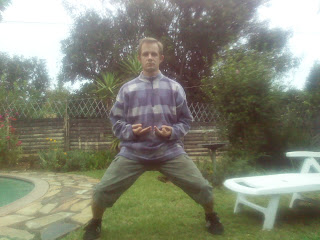Chapter 1: Force- Chi Gong training
To begin my discussion on force I'll state that the Chinese principle holds that qi- or energy- is converted into force during the execution of martial arts techniques. Characteristics of good force include the ability to hit hard, the ability to withstand blows, stamina and physical strength.
I'll deal with all the exercises in my force training programme in due course. For now I'll start with my Qigong exercises and gathering Qi.
The first video shows the first two exercises. While performing the exercises the mind is calm and following the breathing. Inhale raising the hands and exhale lowering the hands. As shown- I repeat it ten times.
The second exercise is very helpful in teaching you to feel your own Qi. Inhaling, feel your hands rise by themselves- very much like Helium balloons. When exhaling feel the pulling force between the palms and the earth. Feel gravity pulling the whole body down.
Posture is very important. The basic principle is that the upper body parts are resting on the lower parts so that, in a relaxed state, gravity will hold it all together instead of toppling the entire structure. Feet are parallel facing forward. Knees are never locked, but pushing outward. Shoulders are relaxed- not forced down or shrugged up, but relaxed. The back is kept straight. The sacrum (tailbone) is always pointing straight down- no angle. This means that the hips have to push slightly forward when standing up straight and that one does not crouch too low when crouching into the horseriding stance.
The pictures show the next two exercises. The horseriding posture with the hands lowered is first. Maintaining the correct posture as explained above inhale drawing breath into the abdomen, causing the abdomen, instead of the chest to expand. Exhale keeping the correct posture. If the posture is correct the abdominal muscles will contract and flatten while exhaling. Repeat ten times. Good abdominal workout. The index fingers are kept curled up underneath the thumbs.
Next exercise requires the hands to be raised and held forward, palms facing toward you while the arms are held in the embracing posture shown. Shoulder should be relaxed. If the shoulders and neck are relaxed you will feel the invisible force pulling your hands together and toward you. Exhaling will cause the force to expand and push the hands away from the body. Repeat ten times.
The last video shows the fifth exercise. Inhaling, circle the arms upward as shown, standing on tiptoe as the lungs fill up and the hands reach the highest point. Exhaling, sink into a horseriding stance bringing the palms in front of the body. If the arms, shoulders and neck are relaxed the hands can be felt repelling each other.
Lastly, meditation- whether done in a standing or sitting position also require the back to be straight and the arms, shoulders and neck to be relaxed. The mind is to be kept quiet, not focussing on anything. If you have trouble with controlling thoughts you can keep your mind focussed on your breathing. Some people like to visualise themselves inhaling positive healthy energy and exhaling stress and negativity. If following breath does not help the best way to start with is counting breath. Exhalations are counted up to 10. When 10 is reached you have to start at 1 again and repeat. If you lose count or get distracted you start at 1 again. Whichever method is used posture and relaxation are the important elements. Chi will be felt coursing through the arms and hands as a tingling sensation.
Well- that about introduces Chi-kung. I usually use these exercises during warm-up before I start physical training. Usually I start with my legs before I get to these exercises. The leg and torso exercises I'll deal with later on.
Next post will show some force channeling exercises.



Comments
Post a Comment